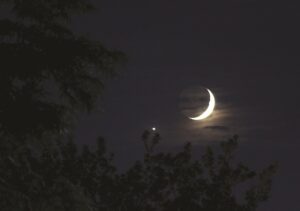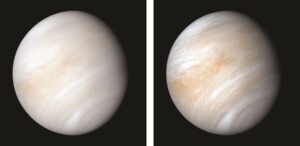Have you noticed the very bright star in the west these past few months? That’s the planet Venus. Among the denizens of the night sky, its brilliant blue-white light is second only to the Moon’s in brightness. Step outside at dusk, look up into the west, and you can’t miss it.
Venus is known as both the Evening Star and the Morning Star. Because of its orbit in relation to Earth, Venus will sometimes appear after sunset in the west: the Evening Star. At other times of the year, Venus rises in the east at dawn ahead of the rising sun: the Morning Star. Right now, it’s the Evening Star and will continue gracing the western sky after sunset well into summer.

Venus will vanish for couple of weeks at the end of July as its orbit takes it behind the Sun from our perspective. Then in mid-August, it will emerge on the other side of the Sun and take up its role as the Morning Star.
Some ancient astronomers, understandably, believed the Evening and Morning Stars to be two different objects. Others recognized the pattern of Venus in the sky and understood that it was a single object. But even when they did, they tended to give separate names to Venus in its different roles. Thus we have lovely names for the Evening and Morning Star in many languages besides English. The Romans called it Vesper (Evening Star) and Lucifer (Light-bringer), which in turn were translations or adaptations of the older Greek names Hesperos (Western-one) and Phosphorus (Light-bringer). Five thousand years ago, the ancient Egyptians called Venus Ouaiti and Tioumoutiri (evening and morning star, respectively).
Breaking the pattern, the Maya knew that Venus was a single object and gave it a single name: Noh Ek’, the Great Star. It was a very important part of their religious beliefs. Maya astronomers carefully tracked Venus’s motion and even observed it in the daytime; this is possible only if you know exactly where to look for it. We also have records of their meticulous observations of Mars and other objects and their precise eclipse predictions. And they did all of this between about the years 200 and 900. The Maya were impressive astronomers for any age.

Venus is a pretty star, but it’s not a nice planet to visit. It has a very dense atmosphere of mostly carbon dioxide and is completely covered with thick clouds of sulfuric acid. The pressure on the surface — the weight of the dense atmosphere that would be pressing down on you if you were unwise enough to land there — is over 90 times that of Earth. Venus would instantly crush an Earthling visitor. And if the pressure didn’t get you, the heat would. All that carbon dioxide has created a runaway greenhouse effect, trapping energy from the Sun rather than allowing it to radiate back into space. Surface temperatures on Venus average 800 degrees Fahrenheit.
There’s not much to see, anyway. Photos from the handful of sturdy landers that have survived on the surface for just a few minutes (contrast that with over six years for the rover Spirit driving around on Mars) reveal a bleak landscape of fractured rock, ancient lava flows, and bare mountains. Scientists think that billions of years ago Venus may have had a more hospitable climate and maybe even oceans. But the runaway greenhouse effect was unstoppable once started. That should give us pause.
But I digress. What we have right now in Venus is a lovely sight in our sky. Those thick, sulfuric acid clouds reflect a lot of sunlight. (As I mentioned earlier, the light that does get through is then trapped.) The reflected sunlight makes Venus a very bright object. Astronomers measure the brightness of astronomical bodies with the term albedo. Venus has an albedo of 0.69, measured from 0 (totally black) to 1 (reflecting 100 percent of the light received). So, it reflects almost 70 percent of the sunlight striking its clouds. For comparison, Earth has an albedo of only 0.3, or 30 percent.
You may never have seen the Morning Star. It can feel like a special friend for very early risers, dedicated observers, and Maya astronomers. But the Evening Star is for everyone. I encourage you to spend some time admiring its beauty. Clear skies!



